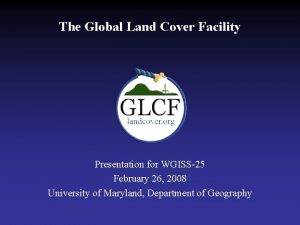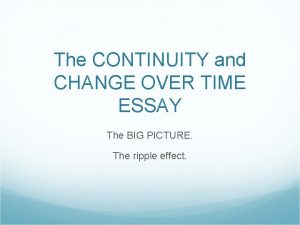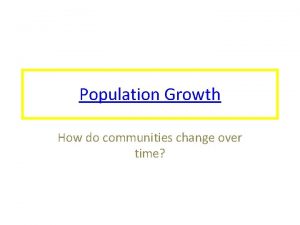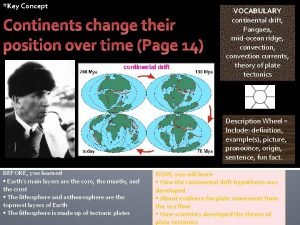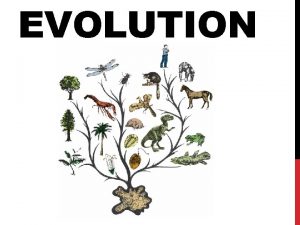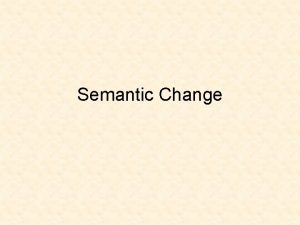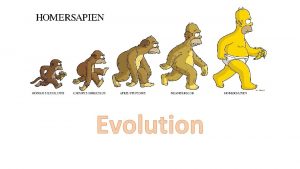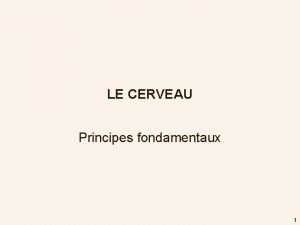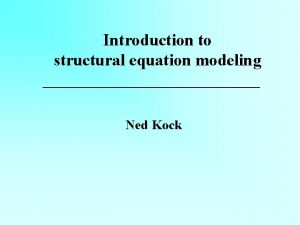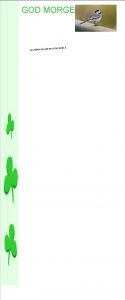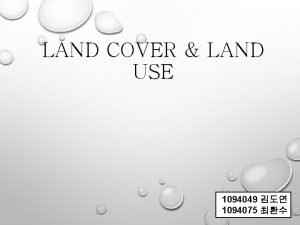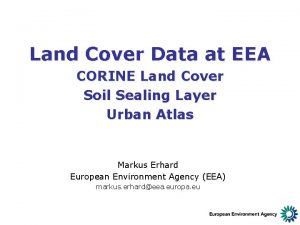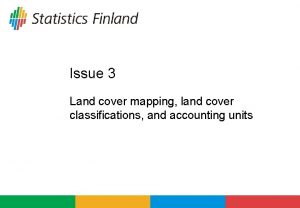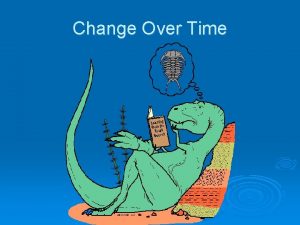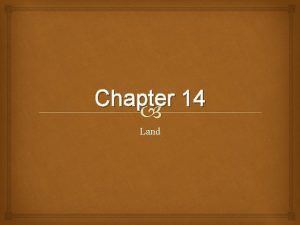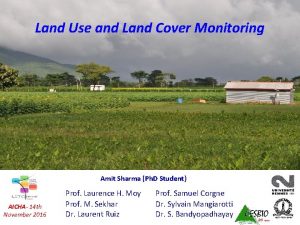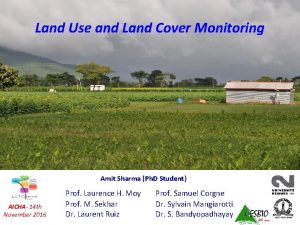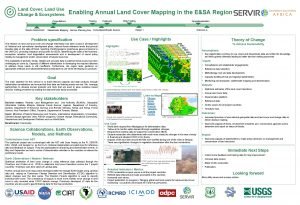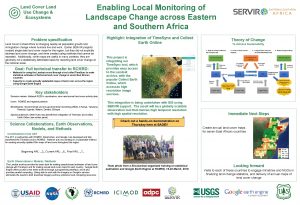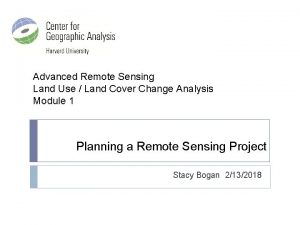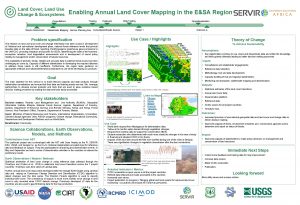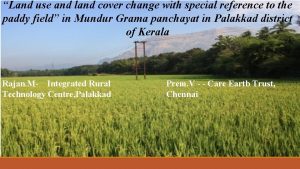Land Cover Change Monitoring change over time Ned


























- Slides: 26

Land Cover Change Monitoring change over time Ned Horning Director of Applied Biodiversity Informatics horning@amnh. org http: //biodiversityinformatics. amnh. org

Land Cover Change early date late date change image

Why monitor land cover change? Identify areas of deforestation/reforestation Monitor growth of urban or rural populations Predict future change based on past change Provide data for climate or carbon budget models Monitor changes in species habitat Monitor changes in agriculture patterns Carbon trading

What are the options for output products? Classified maps Statistics Multi-date visual change images

Classified maps The most familiar type of land cover change product Provides “wallto-wall” mapped output Typically costly and time consuming

Statistics Common during the early years of remote sensing Relies on sampling statistics Primary disadvantages are that accuracy is lower and mapped output is not created Forest unchanged 6271 Hectares 67. 4% Non-forest unchanged 2823 Hectares 30. 3% Deforestation 212 Hectares 2. 3% Total area 9306 Hectares 100%

Visual change image Very quick and easy method for illustrating change Requires minimal skill to create the visualization Red = Band 5 most recent image Green = Band 5 older image Blue = Band 5 older image Interpretation requires familiarity of the landscape No quantitative/classified product is produced

Classification approaches Post classification Multi-date composites Image math Spectral change vectors On-screen digitizing/editing On-screen swipe or flicker Multi-temporal RGB image Hybrid approaches

Comparing two classified images (post-classification) Very intuitive Rarely the most accurate because errors from each land cover classification are added together Early date Late date Change image

Multi-date composite classification Combines imagery from two dates into a single multi-date image Multi-date image is classified using the automated classification method of choice Advantage is that change classes are directly output Often the method of choice

Image math TM band 5 early date TM band 5 late date Uses single-band products (i. e. , image bands or NDVI) from each date Easy and fast to compute Output shows areas that have changed from one date to the next Often used to create a mask highlighting areas that have undergone some sort of land cover change Difference image Image mask white = change

Spectral change vectors Produces a magnitude of change image (similar to image math) and a direction of change image

On-screen digitizing / editing Sometimes called heads-up digitizing Visual methods are used to manually outline areas that have been visually identified as changing from one cover type to another Editing/updating previous land cover maps with more recent imagery can provide a reliable land cover change map Requires familiarity of landscape

On-screen swipe or flicker Visual assessment only Often used to help with on-screen digitizing

Multi-temporal RGB image Visual assessment only Often used to help with on-screen digitizing Red=band 5 late date Green=band 5 early date Red=band 5 early date

Hybrid approach Uses a combination of manual and automated classification methods Use automated methods to classify the image and then manual methods to edit the classification to improve accuracy Use automated methods to classify the “easy” classes and manual methods for the rest Use automated methods to create land cover for one date then edit the land cover map to determine change

Dealing with different data sources Difficult/impossible to use similar imagery when conducting land cover change over a long time period On-screen digitizing works well since the human brain is pretty good and sorting through the different image qualities when using multiple image types Post-classification is an alternative if automated methods are preferred Normalize all images to a common reference

What about data normalization Goal is to make the two images similar with respect to radiometric and geometric qualities Accurate image-to-image registration is very important when using automated methods to avoid false change due to offset pixels between dates Image-to-image registration is more important than absolution image registration Radiometric normalization reduces the change in pixel value between two dates caused by factors other than changes in land cover

Issues to consider Sensor characteristics (resolution, radiometric) Solar illumination / seasonality Soil moisture Acquisition date and frequency Water levels (tide, river and lake level)

Vietnam case study Change detection in central Vietnam Wanted to monitor changes in land cover from the early 1960’s to the present Wanted to use four or five time periods Decided to use ASTER, Landsat ETM+, Landsat TM, Landsat MSS, Corona, and aerial photography. Use primarily visual methods for mapping land cover change

Historical land cover change in Central Vietnam • Understand critical biodiversity needs • Determine how the landscape has taken shape • Support the development of protected areas Red-shanked Douc Langur Saola http: //www. szgdocent. org/pp/p-douc. htm http: //www. wwfindochina. org/conservation/species/saola. htm Giant Muntjac http: //coombs. anu. edu. au/~vern/species/schaller. html

Vietnam’s Central Truong Son

Landsat ETM+ Digital color infrared Acquired: April 21, 2003 Spatial resolution: 30 meters

Landsat TM Digital color infrared Acquired: February 17, 1989 Spatial resolution: 30 meters

Landsat MSS Digital color infrared Acquired: March 14, 1975 Spatial resolution: 57 meters

Corona Panchromatic (b/w) film Acquired: March 2, 1969 Spatial Resolution: 3 meters
 Heterophoria vs heterotropia
Heterophoria vs heterotropia Vike vicente
Vike vicente Cover uncover test vs alternating cover test
Cover uncover test vs alternating cover test Uncentered commercial (strip) development
Uncentered commercial (strip) development Glcf data and products
Glcf data and products Change continuity over time essay example
Change continuity over time essay example How do communities change over time
How do communities change over time A change of position over time
A change of position over time The gradual change in a species over time
The gradual change in a species over time Semantic shift example
Semantic shift example Change in hereditary features over time
Change in hereditary features over time The gradual change in living communities
The gradual change in living communities Evolution
Evolution Change in hereditary features over time
Change in hereditary features over time Gradual change
Gradual change Why do classification systems change over time?
Why do classification systems change over time? An area of land largely enclosed by higher land
An area of land largely enclosed by higher land High rocky land usually with steep sides
High rocky land usually with steep sides Simpsons mbti types
Simpsons mbti types Ned is a typewriter repairman
Ned is a typewriter repairman Ned language
Ned language National endoscopy database
National endoscopy database Ned herrmann
Ned herrmann Ned kock
Ned kock Flaggtider ned
Flaggtider ned Ned herman
Ned herman Curphy followership model
Curphy followership model




